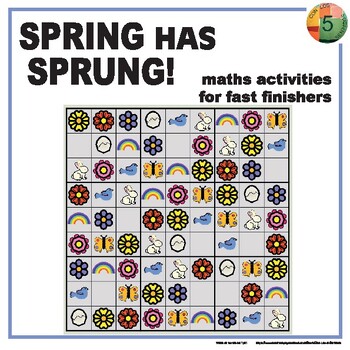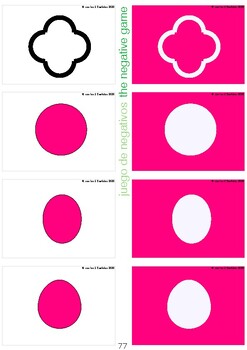SPRING - morning work & fast finishers MATH games & activities
- PDF
Also included in
- SPRING HAS SPRUNG! Bilingual resources Spring inspiredMathsEnglish and Spanish languageArtScienceActivitiesNew resources will be added regularly that you can access for freeSe añadirán nuevos recursos regularmente a los que podrás acceder gratuïtamentePrice $24.99Original Price $38.25Save $13.26
Description
Spring has sprung / reggio emilia inspired MATH activities
Sorting colours.
1 x A4 colour scale (to add to bulleting board)
20 colour cards
Game of negatives. Find the figure that is the negative of the original
16 paying cards FLOWERS.
16 paying cards GEOMETRY.
1 template for student to create their own negative figure
Sorting game. Sorting figures by size.
16 playing cards FLOWERS
Symmetry to paint or play with mirrows. Can be used to do a collage with colour papers
4 x A4 figures FLOWERS
Find the missing piece
8 x A4 figures FLOWERS
16 playing cards missing parts
Mandalas with numbers. (Bilingual English&Spanish)
3 x A4 figures (x2 English&Spanish)
3 x A4 solution
1 template for student to create their own mandala
Find the right patern. Number recognition 1 to 4.
6 x A4
Sudoku. Sudoku with diferents drawings. Number solution from 1 to 9 recognition.
6 x A4 Sudokus, solutions and others
Seriation. Seriation patterns with figures.
20 cards
4 template for student to create their own pattern
Counting 1-10. Need some counters or beads to count.
1 x A4
Counting 10-100, ten by ten. Need some counters or beads to count.
1 x A4
Counting 1-10. Paint.
1 x A4
Counting 10-100, ten by ten. Paint.
1 x A4
Results Counting 1-10. Counting 10-100, ten by ten.
1 x A4
Number puzzle Counting 1-10, 1-20 and 10-100 ten by ten.
20 x 2 playing cards EGG
20 x 2 playing cards RAINBOW
20 templates for student to create their own puzzle
Counting 1 to 10 and 10 to 10, ten by ten, forwards and backwards
12 x A4 CATEPILLAR game
19 playing cards
Fast finishers activities / Special needs activities / Classroom activities
By sorting elements by a color scale, the student practiced basic math concepts of sequencing and patterns.
Comparing the natural elements to color cards provided the student with a hands-on experience in classification and categorization, boosting their logical thinking skills.
Engaging in the activity encouraged the student to recognize similarities and differences in colors, aiding in their understanding of visual representation and organization.
Student demonstrated understanding of relative size by successfully sorting figures from smallest to largest.
The activity helped the student improve their fine motor skills while manipulating and organizing the different figures.
By engaging in sorting activities, the student gained a foundational understanding of classification and categorization in mathematics.
Student has grasped the concept of symmetry by understanding that a figure can be divided into two equal parts where one half is the mirror image of the other.
Through this activity, the student has enhanced their spatial awareness and geometric understanding by recognizing symmetrical patterns and shapes.
The student has developed problem-solving skills as they analyze the incomplete figure and strategically determine the missing part based on its symmetry.
By using a mirror to create symmetry, the student has improved their fine motor skills and hand-eye coordination.
The student showed an understanding of spatial awareness by recognizing the missing piece's placement within the figure.
Problem-solving skills were enhanced as the student logically deduced the missing piece based on the pattern of the other shapes.
Critical thinking skills were developed as the student analyzed the shape's characteristics and compared them to find the correct missing piece.
The activity helped improve the student's attention to detail as they carefully observed the figure to identify the missing element.
The student reinforced counting skills as they used numbers from 1 to 10 to paint or create the mandala, providing a practical application of mathematical concepts.
Understanding of basic geometry was introduced as the student followed lines and symmetry axes to build a cohesive design.
Pattern recognition and repetition were emphasized in the activity as the student identified and replicated numerical sequences within the mandala.
By dividing the mandala into sections based on numerical values, the student engaged in early mathematical partitioning and grouping.
The student practiced creativity and self-expression by designing their own mandala. This allowed them to explore different shapes and patterns.
By incorporating symmetry axes into their mandala design, the student learned about balance and symmetry in art
Through this activity, the student developed fine motor skills by using a brush or finger to paint the detailed sections of the mandala.
Student likely grasped the concept of sequencing numbers based on visual patterns in figures.
Through this activity, the student may have enhanced their understanding of number recognition and association with visual representations.
The student might have developed problem-solving skills by identifying the relationships between numbers and corresponding figures.
The activity could have helped the student recognize and extend simple patterns, fostering their logical thinking abilities.
Student has developed an understanding of sequencing and pattern creation through the activity of seriation with figures
Engaging in this activity has helped the student improve their problem-solving abilities by experimenting with different arrangements and sequences.
The concept of seriation has introduced the student to the idea of logical order and progression in a visual and hands-on manner.
The student has successfully grasped the concept of counting from 1 to 20 by ones, showcasing knowledge of sequential numbers.
Practicing counting from 1 to 20 has improved the student's number recognition and sequencing skills.
By counting from 1 to 10 by one forwards and backwards, the student demonstrates an understanding of skip counting and number patterns.
By counting from 10 to 100 by tens forwards and backwards, the student demonstrates an understanding of skip counting and number patterns.
Engaging in number puzzles has enhanced the student's problem-solving abilities and critical thinking skills.






